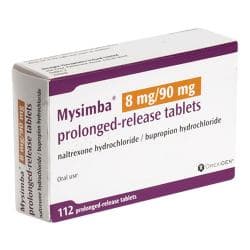Login to your account
- Prescription included
- Genuine medication
- All-inclusive service - No hidden fees
- Free next-day delivery
Mysimba’s side effects and management
Discover the side effects of Mysimba tablets for weight loss
Mysimba is a weight loss medication which contains the active ingredients naltrexone and bupropion hydrochloride. In studies, 23.8% of patients taking Mysimba and 11.9% taking the placebo stopped treatment because of side effects.
If you are planning to start taking Mysimba, it’s important to be aware of the potential side effects you could experience. This article will highlight both, common and uncommon side effects and how to manage them.
What are the most common side effects of Mysimba?
Like with any medication, there’s a chance of experiencing side effects while taking Mysimba. Side effects vary from person to person. However, not everyone who takes this medication will experience side effects.
The most common side effects of Mysimba include:
|
|
Gastrointestinal problems
In studies, side effects such as nausea, constipation, and vomiting were very common, affecting 1 or more people out of 10.

Patients reported nausea as one of the reasons they stopped treatment. However, it is only common in the first month of treatment and usually goes away with time.
Tiredness
Mysimba can also make you feel tired and sluggish. Studies have shown that there is a link between obesity and daytime sleepiness as well as fatigue.

When you start taking Mysimba you may feel more tired than usual. This might be because it makes you feel less hungry, thereby reducing the amount of food you eat which can affect your energy levels. However, as you adjust to eating less, your energy levels may improve over time.
Trouble sleeping
Around 1 in 100 people or more report difficulty sleeping when taking Mysimba. This is quite common, especially when the dose is increased. However, research suggests that this is not serious and usually goes away with time.
It may help to take the evening dose earlier in the day, but at least 8 hours after the morning dose. If this is ongoing, ensure you tell your doctor.

Other side effects such as dizziness, dry mouth or headaches generally settle after a few days. These should be reported to your doctor if they bother you.
What are the less common side effects of Mysimba?
The following side effects are rare. However, it’s important to be aware of all the potential risks when starting a new medication.
|
|
Seizures and loss of consciousness
It is estimated that seizures may occur in around 0.1% of people (1/1,000). The most common type of seizure is generalised tonic-clonic seizures.
Mysimba may make some people feel drowsy or lose consciousness. Avoid driving or operating machines until these side effects have resolved.
If you experience any of these side effects seek medical attention immediately.
Psychiatric disorders
Rarely, Mysimba may cause hallucinations or agitation as a result of serotonin syndrome. This happens when the levels of a chemical called serotonin in your brain become too high.
It's usually triggered when Mysimba is taken together with another medicine (or substance) that also raises serotonin levels. These could be antidepressants called selective serotonin reuptake inhibitors (SSRIs) or serotonin norepinephrine reuptake inhibitors (SNRIs).
See a doctor immediately if you develop these side effects.
Mental health problems
Although it is rare, there have been reports of depression, suicidal thoughts, and suicide attempts during treatment with Mysimba.
If you have suicidal or distressing thoughts, or if you are depressed and notice that you feel worse contact your doctor or go to a hospital straight away.
Allergic reations
If you have signs of an allergic reaction, stop taking this medicine and see your doctor immediately. These may include the following:
- skin rash or hives
- chest pain
- swelling
- shortness of breath
For a full list of Mysimba’s side effects, please consult the patient information leaflet included with your order.
How long do Mysimba’s side effects last?
As each person reacts differently to medicines there’s no way of knowing exactly how long side effects last. Also, not everyone who takes Mysimba will experience side effects.
Usually, side effects are worse when you first start treatment and gradually go away with time as your body adjusts to the new medicine. This could take a few days or even a few weeks.
You may also experience side effects when your doctor increases the dose of your medicine.
Other factors such as pre-existing medical conditions and other medications you take could also influence the side effects you experience and how long they last.
When you start Mysimba, you will begin on the lowest dose and gradually increase it each week until week 4. This gives your body time to adjust to the medicine and reduce the risk of side effects.
How can I manage Mysimba’s side effects?
You may be able to manage the common side effects of Mysimba by making simple lifestyle and dietary changes or by adjusting your dose.
Lifestyle and dietary changes
Since nausea is one of the most common side effects patients experience while on Mysimba, it’s important to know how you can manage this.
Some effective strategies may include:
- taking the tablets with food
- eating bland foods such as crackers, plain toast, baked chicken, and rice
- avoid eating large meals, instead try eating smaller portions more often
- avoid foods with strong smells
- sit up after you eat and avoid lying down straight after a meal
- eat slowly, chewing each mouthful thoroughly before swallowing

It’s important to eat a reduced-calorie, healthy diet while taking this medicine. You should also be aware of foods to avoid while on weight loss treatment. These include:
- fatty foods (including fast food, processed meat and butter)
- sugary foods (including pasties, cakes and sweets)
- salty foods (such as crisps, bacon, cheese)
- alcoholic beverages
Changing your dose
If you're experiencing side effects from Mysimba, adjusting the dosage may help reduce this.
Speak to your doctor about changing your medication dosage. They can see whether a dose change is appropriate and what your new dosage should be. They may also consider other factors such as your weight loss progress and any other medications you're taking.
When should I report my side effects?
You should report any side effects that bother you or are concerning to your doctor as soon as possible. Some side effects such as nausea and constipation are very common and usually subside with time. However, if these are too hard to manage it’s best to report them to your doctor.
Some side effects may require immediate medical attention, such as severe allergic reactions, difficulty breathing, chest pain, or other serious symptoms. If you experience any of these, seek medical help right away.
Further reading

Understanding Saxenda Side Effects
Reviewed by Dr. Caroline Fontana
Understanding Wegovy side effects
Reviewed by Dr. Caroline FontanaSelect
medicationFill out a short
medical formDoctor issues
prescriptionMedication sent
from pharmacy

